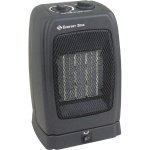I mentioned previously that we will be keeping C-Dancer on the trailer here in Seattle throughout the winter and probably beyond. The main reason is to allow me to do projects from fall through spring without having to drive 2 hours. We have access to electricity and water so I think it will work out great.
I bought a small ceramic electric heater from West Marine to keep the cabin warm and dry in the winter. It has several safety features (see below) but for some reason, I'm a little uneasy about having a heater run all winter.
My question: Do you feel safe running a small electric ceramic heater in your cabin all winter?
Description of: Comfort Zone Oscillating Ceramic Heater/Fan
"Keep your comfort level at an optimum with this portable oscillating heater/fan. It features a four-position rotary dial to adjust the settings, adjustable thermostat, oscillation option, safety tip-over switch, safety overheat protection system, stay cool body with molded handle, power indicator light, and a 6' power cord."
Watts: 750/1500
BTUs: 5120
Amps: 12.5
HZ: 60HZ
Volts: 120
Dimensions: 5"L x 6"W x 10 3/4"H

I bought a small ceramic electric heater from West Marine to keep the cabin warm and dry in the winter. It has several safety features (see below) but for some reason, I'm a little uneasy about having a heater run all winter.
My question: Do you feel safe running a small electric ceramic heater in your cabin all winter?
Description of: Comfort Zone Oscillating Ceramic Heater/Fan
"Keep your comfort level at an optimum with this portable oscillating heater/fan. It features a four-position rotary dial to adjust the settings, adjustable thermostat, oscillation option, safety tip-over switch, safety overheat protection system, stay cool body with molded handle, power indicator light, and a 6' power cord."
Watts: 750/1500
BTUs: 5120
Amps: 12.5
HZ: 60HZ
Volts: 120
Dimensions: 5"L x 6"W x 10 3/4"H

